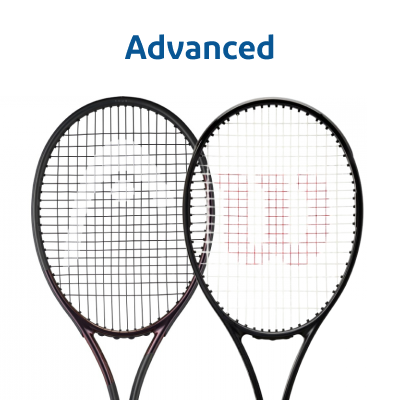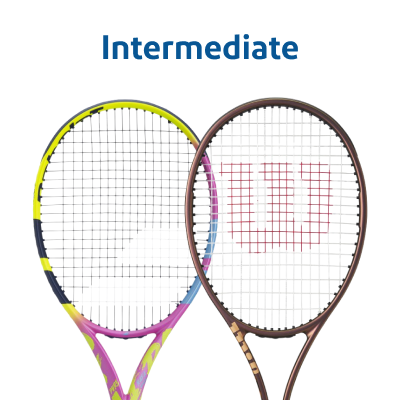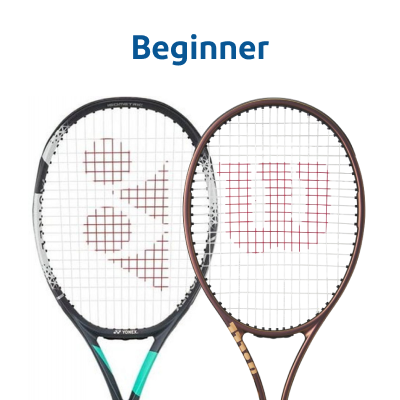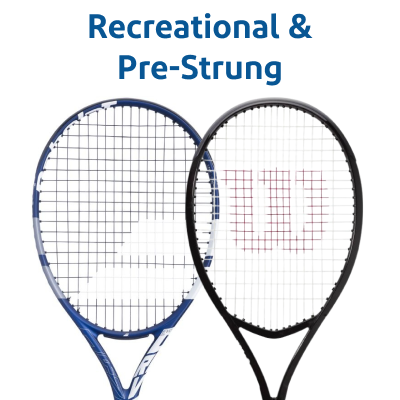Shop for Racquets Based on Tennis Skill Levels
Racquets Based on Tennis Skill: Your Guide
Choosing a tennis racquet is a big decision and a personal decision. You will want to sure you have the right racquet for your skill level and power level allowing you to improve as a player. Some players may need to find a racquet that helps with power, while others need more control. Let Do it Tennis help you identify the things to consider when choosing your racquet.
Criteria to Consider
Balance: The midpoint along with the racquet as measured from butt to head is used as the starting point to measure balance. If the racquet is evenly balanced, its weight will be evenly distributed on either side of the midpoint, so that if you hold the racquet parallel to the floor between your thumb and forefinger at this point, the racquet will hang evenly. If the racquet is head heavy, more weight is at the head end and the racquet will have more swing weight. If the racquet is headlight, more weight will be at the butt-end and it will have less swing weight. Head heaviness or lightness is measured in points.
Beam Width: Think of it as the thickness of the racquet. Look at the racquet from the side - its width is the beamwidth. A thick beam width means stiffness and more power. A thinner beam width means flexibility and less power.
Composition: The materials that the racquet is made of define the racquet’s composition. Graphite, titanium, ceramics, aluminum and fiberglass are the principal materials used in modern-day racquet construction.
Flexibility: The opposite of stiffness, flexibility describes how much the racquet frame will yield upon impact with the ball. The more flexible a frame is, the less powerful the racquet. If you want to reduce the shock that comes up your arm when striking the ball, look for a racquet with high flexibility.
Head Size: Tennis racquets typically come in one of three head sizes: midsize, mid-plus, and oversize. General industry guidelines say that a midsize racquet will offer between 85 to 95 sq. inches of hitting area, a mid-plus racquet will offer between 95 to 105 sq. inches of hitting area and an oversize racquet will offer more than 105 sq. inches of hitting area.
Length: Length is measured from the edge of the butt to the peak of the head.
Maneuverability: A racquet that has good maneuverability allows you to adjust its position quickly and easily in the middle of play.
Power Level: How much punch the racquet packs is the power level. A high power level racquet will generate lots of pop on the ball but will place less emphasis on control, whereas a low power level racquet will leave it up to you to do provide the power through a bigger, more aggressive swing while giving you more control.
Stability: As you come through the ball on your swing, you want the racquet to stay on a true path and not deviate from it or wobble around. The less the racquet wants to deviate from the arc of your swing as it impacts the ball, the more stable it is. Head weight increases stability, as does a larger hitting area.
Stiffness: Just like it sounds, the stiffness describes how rigid the frame is. This is an important factor relating to power. If you want more power and less control out of your racquet, select one that has greater stiffness.
String Pattern: This is the number of mains (strings going up and down, from handle to head) and crosses (strings going left to right) that create the string bed. A tighter, closer string pattern is known as a dense string pattern and it puts more strings in contact with the ball. If you want more control over your shots and are not concerned so much with power, you want a dense string pattern. An example of a dense string pattern is 18 mains x 20 crosses. In contrast, an open string pattern generates more power but less control. An example of an open string pattern is 14 mains x 18 crosses.
String Tension: Each tennis racquet has a suggested range of string tension. The manufacturer has tested the frame and determined the optimal range of tensions to set the strings for best play and longevity of the frame. As a general rule, if you string at the lower end of your racquet’s recommended tension range, the same stroke will make the ball fly farther. Adjust string tension according to desired effect. Low tension = deeper shots. High tension = shorter shots.
Swing Speed: How fast you swing the racquet is your swing speed. If you have a fast swing speed, you generate more power and so you don’t need the racquet to do this for you. A high-powered frame will send the ball flying and your shots will go long. If your swing speed is slower, you may need a racquet that generates more power. Of course, adjusting string tension will also impact how the ball comes off the racquet and can be used to fine-tune your “power setting.”
Swing Weight: The swing weight of the racquet is how heavy the racquet feels when you swing it. The more weight you have distributed to the head of the racquet, the higher the swing weight will be. If you have more of the racquet’s weight close to the handle, the swing weight will be lower. Also, extra-long racquets have a higher swing weight since there is more weight further from your hand due to the longer frame.
Weight (Unstrung): Refers to the racquet weight prior to stringing. As a general rule of thumb, the bigger the head size the lighter the racquet. This seems counter-intuitive but nonetheless, it’s true. Larger head-size racquets are typically lighter than smaller head-size racquets. This is a reflection of the preferences shown by the typical users of mid, mid-plus, and oversize frames. Advanced players prefer heavier frames with lower power ratings that favor control and shot placement. Beginner players prefer lighter frames with higher power ratings that favor power and the maneuverability that comes with a light racquet.
Do it Tennis will help you will find the perfect tennis racquet that fits your skill level.









